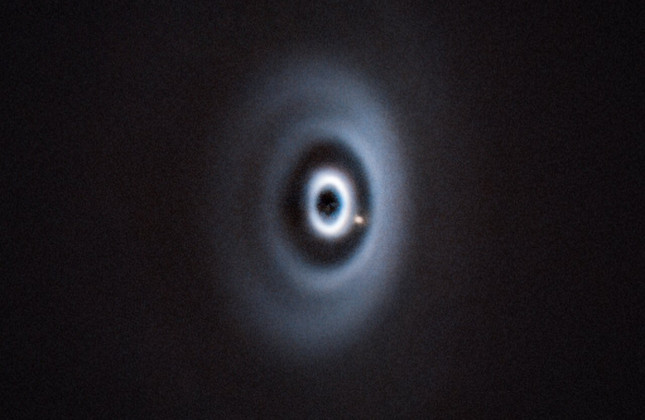In the past decade, advancements in observational astronomy have revolutionised our ability to study the birth environment of planets around young stars. There are hundreds of high-resolution images of planet-forming disks, many of which show substructures - such as rings and spiral arms - that are thought to be indicative of forming planets.
However, there have been no confirmed detections of embedded planets since the discovery of PDS 70’s planetary system in 2018. The planet formation community has been actively searching for another such system for the past seven years.
The team now found such a planet with a survey program called ‘WIde Separation Planets In Time’ (WISPIT), using the SPHERE instrument on the VLT. They named the newly discovered system WISPIT 2, and the planet WISPIT 2b.
First author Richelle van Capelleveen (Leiden Observatory, Netherlands): “Discovering this planet was an amazing experience - we were incredibly lucky. WISPIT 2, a young version of our Sun, is located in a little-studied group of young stars, and we did not expect to find such a spectacular system. I am so grateful for all the work put in by our international partners, especially the graduate student group at University of Galway (Ireland), who really helped us announce this system to the community in record time.”
Firsts
Van Capelleveen’s supervisor and third author Matthew Kenworthy (Leiden Observatory, Netherlands): “What we present is, after seven years, the first unambiguous detection of an embedded planet since PDS 70. Additionally, it is the first detection of an embedded planet in a cleared gap.”
Second author Christian Ginski (University of Galway, Ireland) adds: “This is strong direct observational evidence that the gas giants we have found on wide orbits around slightly older stars can indeed have formed further away from their host stars.”
The team expects that this system will have a huge impact on the planet-formation community and will serve as the benchmark for models of planet formation and planet-disk interactions for years to come.
Understanding how planets form is an important field in astronomy. It is known that planets form in a disk around a young star, and that, in the dominant formation mechanism, the planet first builds up a core and then clears a path in the disk by pulling gas and dust onto itself using its own gravity. To date, astronomers have discovered and confirmed nearly 6000 planets and hundreds of disks, but there was only one system with unambiguously confirmed planets that are still embedded in the disk: PDS 70, a system with two planets residing in a large inner cavity.
Observations
The team obtained two VLT/SPHERE coronagraphic H-band ‘snapshot’ observations of less than 5-minute integration time a year apart and noticed that there was a disk around this star. They thought there might be a planet in the inner gap and scheduled follow-up observations with SPHERE in polarized and unpolarized light to detect both the disk and potentially embedded planets in detail, and contacted the team in Arizona to observe the system in H-alpha light. This is a specific optical wavelength that can be used to look for hydrogen gas falling onto the planet; if a planet is detected in this narrow band, it is a sign that it is accreting (i.e. pulling gas and dust onto itself).
The follow-up infra-red observations provided very strong detections of the planet WISPIT 2b. Reanalysis of the original snapshot observations recovered the planet one year earlier, allowing the astronomers to trace a small part of its orbit.
Laird Close (University of Arizona, US), the lead author for the other paper: “It was incredibly exciting to search the newly discovered disk with 6.5m Magellan telescope and our AO system: MagAO-X. MagAO-X is specially designed to look for hydrogen gas falling onto young planets. As soon as we took a picture, in the light of H-alpha (visibly dark red light), we found a beautiful accreting planet. Our strong H-alpha detection proves it is a very rare example of a growing protoplanet.”
Van Capelleveen says that the team is very excited about the result: “It is such a spectacular system with the striking visual of a planet embedded in the gap of a multi-ringed disk. It is the first ring-shaping embedded planet, which will give the planet-formation community the unprecedented opportunity to learn more about the physics of planet forming disks, in particular how viscous they are, which is a key parameter for how they spread out over time and transport material and angular momentum. This system will likely be a benchmark for years to come.”
Scientific articles:
WIde Separation Planets In Time (WISPIT): A gap-clearing planet in a multi-ringed disk around the young solar-type star WISPIT 2; Richelle van Capelleveen et al.
WIde Separation Planets In Time (WISPIT): Discovery of a Gap H-alpha Protoplanet WISPIT 2b with MagAO-X; Laird Close et al.
The image of WISPIT 2b is ESO's Photo of the Week
